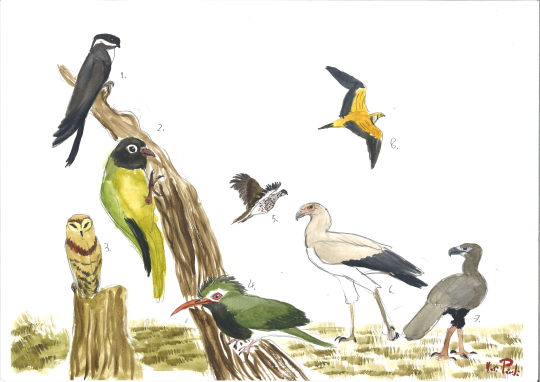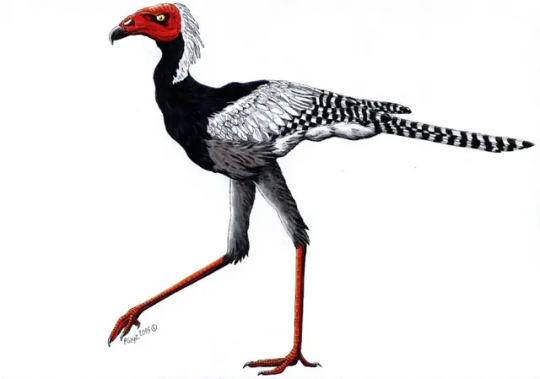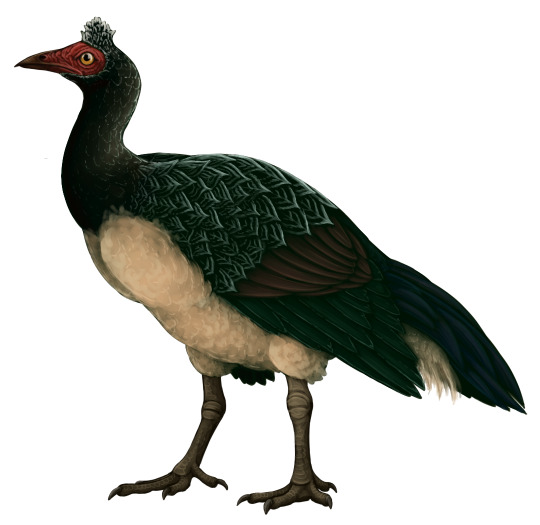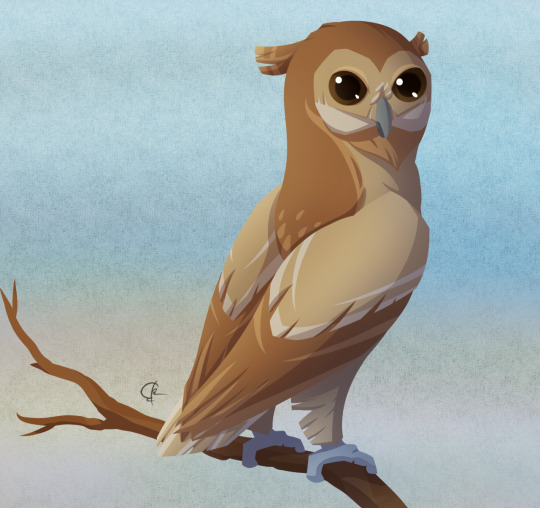#paraortyx
Explore tagged Tumblr posts
Text
Fossil Novembirb: Day 13

The phosphorate beds of Quercy, France preserve a wealth of fossils from the late Eocene and Oligocene epoch, about 35-25 million years ago. At that time, the early Paleogene jungle hothouse had ended. The climate was drying and cooling, and in parts of the world forests were giving way to savannah and scrubland, as was in Quercy. But that didn't stop birds. They started to take advantage of these new wide open spaces.
Aegialornis: An enigmatic bird that was closely related to swifts. Unlike swifts, it could perch and hold on to branches, but it was also an incredible flyer.
Quercypsitta: A unique group of not well known stem-parrots which likely resembled the earlier Halcyornithids, corvid-like stem-parrots from Europe and North America.
Palaeoglaux: Also known from the Messel Pit, this early relatively small owl may have been a diurnal hunter of small prey and had peculiar body feathers.
Sylphornis: A mysterious member of the piciformes with unique morphology, resembling jacamars and puffbirds.
Paraortyx: One of the earliest true phasianid galliforms, related to partridges, pheasants and chickens. It likely had a similar lifestyle to them, only taking flight when necessary.
Pelargopappus: An early relative of the long-legged secretarybird, this Eocene relative stalked the plains in a similar manner, stomping down on any prey it could catch.
Strigogyps: An omnivorous turkey-sized member of the cariamiform family, it is also known from the middle Eocene of Germany.
Archaeoganga: A relatively large and one of the earliest members of that wonderful desert bird clade, the sandgrouse.
#Fossil Novembirb#Novembirb#Dinovember#birblr#palaeoblr#Birds#Dinosaurs#Cenozoic Birds#Aegialornis#Quercypsitta#Palaeoglaux#Sylphornis#Paraortyx#Pelargopappus#Strigogyps#Archaeoganga
37 notes
·
View notes
Text
FOSSIL NOVEMBIRB - DAY 13
Fancy birds! Such as the Paraortyx!

As always, you can get all these cute stuff in my redbubble

#Paraortyx#fossil novembirb#paleobird#paleoblr#paleoart#birdblr#birblr#november prompt list#novembirb
42 notes
·
View notes
Text
Fossil Novembirb 13: French Savannah

Sylphornis by @quetzalpali-art
Whoops I got behind because life sucks but I'm back with the birds of the Quercy Phosphorites! This fossil site is another location of excellent preservation in Europe, dating to the end of the Eocene through the Oligocene. In fact, it shows a lot of how animals continued to evolve post-Messel, and has been compared to the Messel Pit extensively to look at the process of mammalian evolution in Europe!
But we, of course, are here for The Birds. This ecosystem was an open plain, not quite filled with grass as the great Grass Takeover hadn't happened yet. But it wasn't a tropical or subtropical forest like most of the world had been for millions of years by this point. In fact, the Eocene to Oligocene transition would force many animals - including birds - to deal with a more varied landscape for the first time in ages.

Pelargopappus by Piotr Gryz
As with other northern hemisphere ecosystems, we once again find a European locality filled with birds whose relatives live nowhere near Europe today. Pelargopappus, also known as Amphisagittarius, is one of our first known fossil Secretarybirds - and it was from Quercy! In fact, it's possible that the ecology of Secretarybirds as fast running prairie hunters may have evolved due to the decrease of forests during this time.
And it wasn't alone - the relatives of modern seriemas, like Talantatos, remained in the area as predators, and adapted well to the new environments. Along with Elaphrocnemus, it showcases that cursorial predatory birds were major factors in these early plains environments, and may have even been among the leading predators in these ecosystems. Mammalian carnivorans were only just starting to get bigger, and these growing pains allowed birds to fill some of their ancestral dinosaur niches even in Europe.

Talantatos by @drawingwithdinosaurs
Predators weren't the only birds having a grand old time in these new ecosystems. Landfowl, which were surprisingly scarce in earlier fossil records compared to their cousins the Waterfowl, begin to be more common during this time. These ground foragers, such as Quercymegapodius, had more food to pick from on the plains, and they even adapted for short bursts of flight rather than long-term flying in order to escape predators quickly on the open landscape. Relatives of seriemas adapted to herbivory, like Ameghinornis, were present too - there were a lot of grains and seeds to eat, after all!
As they evolved for this new environment, many landfowl experimented with different body proportions - such as Paraortyx, which had extremely lightweight bones, long and slender wings like those of ducks, and short legs like those of chickens. Birds like Paraortyx indicate that the evolution of living landfowl was a stepwise process, with some of the ancestral fowl characteristics sticking around in stem-landfowl such as these birds. Being able to fly well for long periods of time would have helped these birds travel through the landscape, far away from the dangers of the ground.

Paraortyx by @quetzalpali-art
Small, tree dwelling birds were present in the Quercy Savannah as well. Quercypsitta, a potential parrot relative, was a common bird in the ecosystem and may have been more like living parrots than the Parrot-Passerines of Prey we've talked about previously. Trees were still around in this ecosystem, and fighting over niches within them became difficult as all these tree birds now had to live in increasingly limited areas - which may have driven parrot relatives like Quercypsitta into diversifying further, towards the parrots we know today.
We also see early relatives of woodpeckers and barbets! Sylphornis had legs and feet weaker than those of Passerines, but very similar to living woodpeckers. With long slender legs and zygodactylus feet, it was able to perch on the trees effectively and hold onto them while searching for food, a helpful adaptation in an increasingly competitive world. Modern-type birds of prey were beginning to appear as well, with hawk-like animals such as Horusornis showing up more frequently in the fossil record as these open habitats appear. Like living birds of prey, Horusornis probably took advantage of the large landscape to search far and wide for sources of food.

Quercymegapodius by @drawingwithdinosaurs
Wading birds like Itardiornis were also present, though what sources of water they were feeding along is less clear. As terrestrial omnivores, they probably went from water source to water source, searching for anything they could eat in the savannah landscape. Relatives of avocets were also present, indicating probing around in the substrate was something many animals could benefit from in the plains.
The only fossil Toadie is known from Quercy, Palaeotodus, and while they were similar in terms of morphology, they were significantly larger than living toadies with much larger wings proportionally. This probably would have helped these birds go longer distances across the fragmenting landscape.

Palaeoglaux by @quetzalpali-art
Owls continued to adapt to the changing landscapes, competing with new diurnal raptors for niches as these forms began to appear. Palaeoglaux, known from the Messel, was still present in the Quercy Phosphorites, and was probably still diurnal as its earlier form had been, as it had visible display structures. Strisorians were common too, with relatives of nightjars like Ventivorus, potoos like Euronyctibius, and frogmouths like Quercpodargus all present in the ecosystem. This shows that, even as the world cooled, it wasn't quite cold enough for these now-tropical birds to disappear from Europe... yet.
Sources:
Mayr, 2022. Paleogene Fossil Birds, 2nd Edition. Springer Cham.
Mayr, 2017. Avian Evolution: The Fossil Record of Birds and its Paleobiological Significance (TOPA Topics in Paleobiology). Wiley Blackwell.
32 notes
·
View notes
Text
Paraortyx brancoi, P. lorteti

By José Carlos Cortés on @quetzalcuetzpalin
PLEASE SUPPORT US ON PATREON. EACH and EVERY DONATION helps to keep this blog running! Any amount, even ONE DOLLAR is APPRECIATED! IF YOU ENJOY THIS CONTENT, please CONSIDER DONATING!
Name: Paraortyx brancoi, P. lorteti
Status: Extinct
First Described: 1908
Described By: Gaillard
Classification: Dinosauria, Saurischia, Eusaurischia, Theropoda, Neotheropoda, Averostra, Tetanurae, Orionides, Avetheropoda, Coelurosauria, Tyrannoraptora, Maniraptoriformes, Maniraptora, Pennaraptora, Paraves, Eumaniraptora, Averaptora, Avialae, Euavialae, Avebrevicauda, Pygostylia, Ornithothoraces, Euornithes, Ornithuromorpha, Ornithurae, Neornithes, Neognathae, Galloanserae, Pangalliformes, Paraortygidae
Paraortyx is another Paraortygid, our favorite group of duck-ish chickens! Known from the Boom Formation, Quercy Oligocene Deposits, and Weisselsterbecken of Belgium, France, and Germany; it lived between 33 and 28 million years ago, in the Rupelian age of the Oligocene of the Paleogene. Smaller than its close relative Pirortyx, it also showed larger holes in its wings that would have given it more lightweight wingbones, much like Gallilunoides, from a more early derived group of stem-chickens. Beyond that, it seems to have been fairly standardly transitional - with not as many adaptations for peck-feeding unlike modern chickens; longer and slenderer wings like ducks; and short legs like chickens.
Buy the author a coffee: http://ko-fi.com/kulindadromeus
Sources:
Fleagle, J. G., T. M. Bown, J. D. Obradovich and E. L. Simons. 1986. How old are the Fayum primates?. Primate Evolution 1-17
Mayr, G. 2009. Paleogene Fossil Birds. Springer-Verlag Berlin Heidelberg.
Sigé, B., M. Hugueney, J.-Y. Crochet, S. Legendre, C. Mourer-Chauviré, J.-C. Rage, and R. Simon-Coinçon. 1998. Baraval, nouvelle faune de l’Oligocène inférieur de l’Oligocène inférieur (MP 22) des Phosphorites du Quercy. Apport à la signification chronologique des remplissages karstiques. Bulletin de la Société d’Histoire naturelle de Toulouse 134:85-90
#paraortyx#paraortyx brancoi#paraortyx lorteti#bird#dinosaur#chicken#pheasant#dinosaurs#palaeoblr#paleontology#prehistory#prehistoric life#biology#a dinosaur a day#a-dinosaur-a-day#dinosaur of the day#dinosaur-of-the-day#science#nature#factfile#Dìneasar#דינוזאור#डायनासोर#ديناصور#dínosaurio#risaeðla#ڈایناسور#deinosor#恐龍恐龙#динозавр
33 notes
·
View notes
Text
Litoripes medius

By Scott Reid on @drawingwithdinosaurs
PLEASE SUPPORT US ON PATREON. EACH and EVERY DONATION helps to keep this blog running! Any amount, even ONE DOLLAR is APPRECIATED! IF YOU ENJOY THIS CONTENT, please CONSIDER DONATING!
Name: Litoripes medius
Status: Extinct
First Described: 1979
Described By: Harrison & Walker
Classification: Dinosauria, Saurischia, Eusaurischia, Theropoda, Neotheropoda, Averostra, Tetanurae, Orionides, Avetheropoda, Coelurosauria, Tyrannoraptora, Maniraptoriformes, Maniraptora, Pennaraptora, Paraves, Eumaniraptora, Averaptora, Avialae, Euavialae, Avebrevicauda, Pygostylia, Ornithothoraces, Euornithes, Ornithuromorpha, Ornithurae, Neornithes, Neognathae, Galloanserae, Pangalliformes, Galliformes?, Phasianoidea?, Phasianidae?
Litoripes, its name meaning Littoral Foot, is an extremely fragmentary genus of Neornithean that was originally thought to be a Pheasant, though because of its fragmentary nature that’s rather suspect. I don’t... exactly know how it ended up here instead of with the Pheasants on the schedule, but here we are. It is only known from part of a foot bone, coming from the the Bracklesham Beds of the United Kingdom. It probably lived sometime between 48 and 40 million years ago, from the Lutetian age of the Eocene Epoch of the Paleogene. This foot bone seems to resemble that of Paraortyx, which was thought to be a pheasant but has since been only able to be definitely stated as a Pangalliform (the group of dinosaurs more closely related to chickens than to ducks), so the jury is out on Litoripes as well.
Sources:
Harrison, C. J. O., C. A. Walker. 1979. Birds of the British Middle Eocene. Tertiary Research 5: 19 - 27.
Kemp, D., L. Kemp, D. Ward. 1990. An Illustrated Guide to the British Middle Eocene Vertebrates. London, UK.
Mayr, G. 2000. A new basal galliform bird from the Middle Eocene of Messel (Hesse, Germany). Senckenbergiana lethaea 80 (1): 45 - 57.
Mayr, G. 2009. Paleogene Fossil Birds. Springer - Verlag Berlin Heidelberg.
Mlíkovsky, J. 1995. Tertiary Avian Localities of the United Kingdom. Acta Universitatis Carolinae Geological 39 (1995): 759 - 771.
Mourer-Chauviré, C. 1992. The Galliformes (Aves) from the Phosphorites du Quercy (France): Systematics and biostratigraphy. Natural History Museum of Los Angeles County, Science Series. 36. 67 - 95.
Sigé, B., M. Hugueney, J. Y. Crochet, S. Legendre, C. Mourer-Chauviré, J. C. Rage, R. Simon-Coinçon. 1998. Baraval, nouvelle faune de l’Oligocène inférieur de l’Oligocène inférieur (MP 22) des Phosphorites du Quercy. Apport à la signification chronologique des remplissages karstiques. Bulletin de la Socíté d’Histoire naturelle de Toulouse 134: 85 - 90.
Shout out goes to @allybellydinosaurxox-blog!
#litoripes#litoripes medius#bird#galliform#dinosaur#birblr#palaeoblr#allybellydinosaurxox-blog#paleontology#prehistory#prehistoric life#dinosaurs#biology#a dinosaur a day#a-dinosaur-a-day#dinosaur of the day#dinosaur-of-the-day#science#nature#factfile#Dìneasar#דינוזאור#डायनासोर#ديناصور#ডাইনোসর#risaeðla#ڈایناسور#deinosor#恐龍#恐龙
68 notes
·
View notes